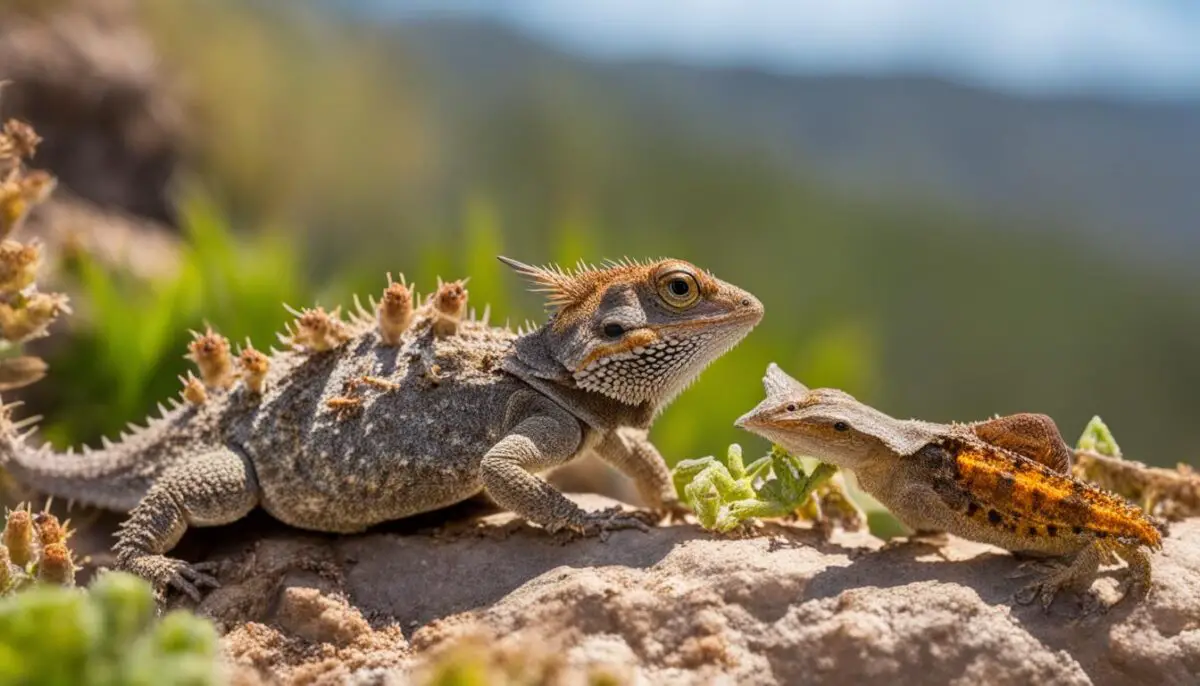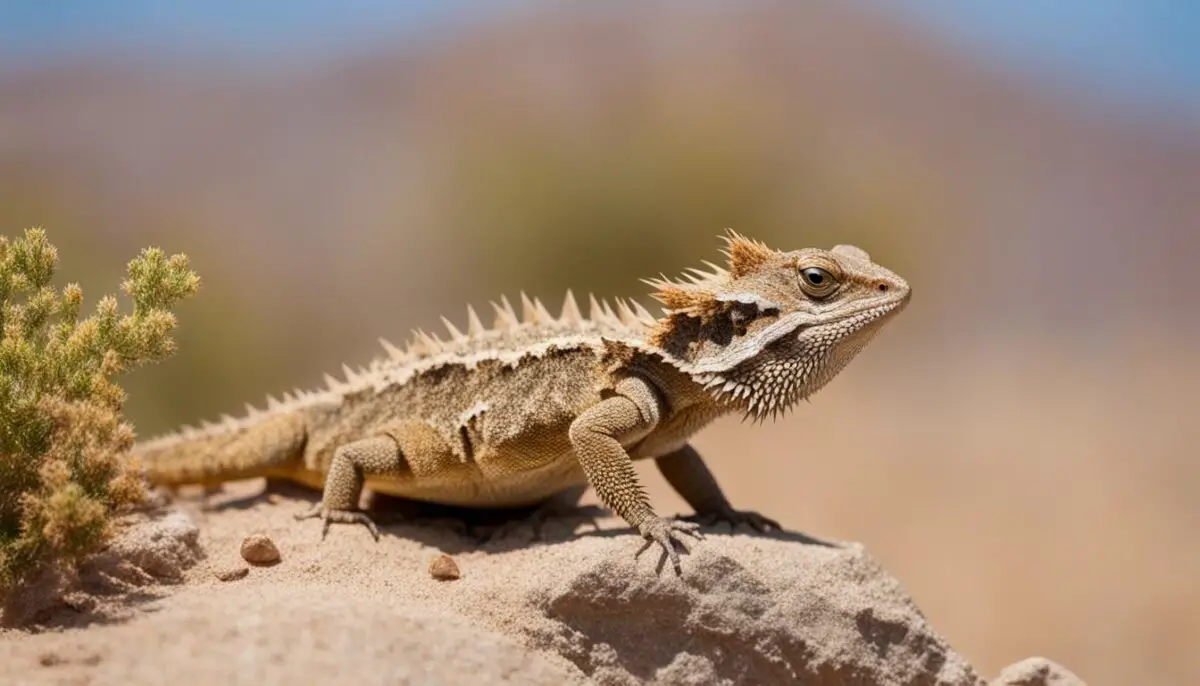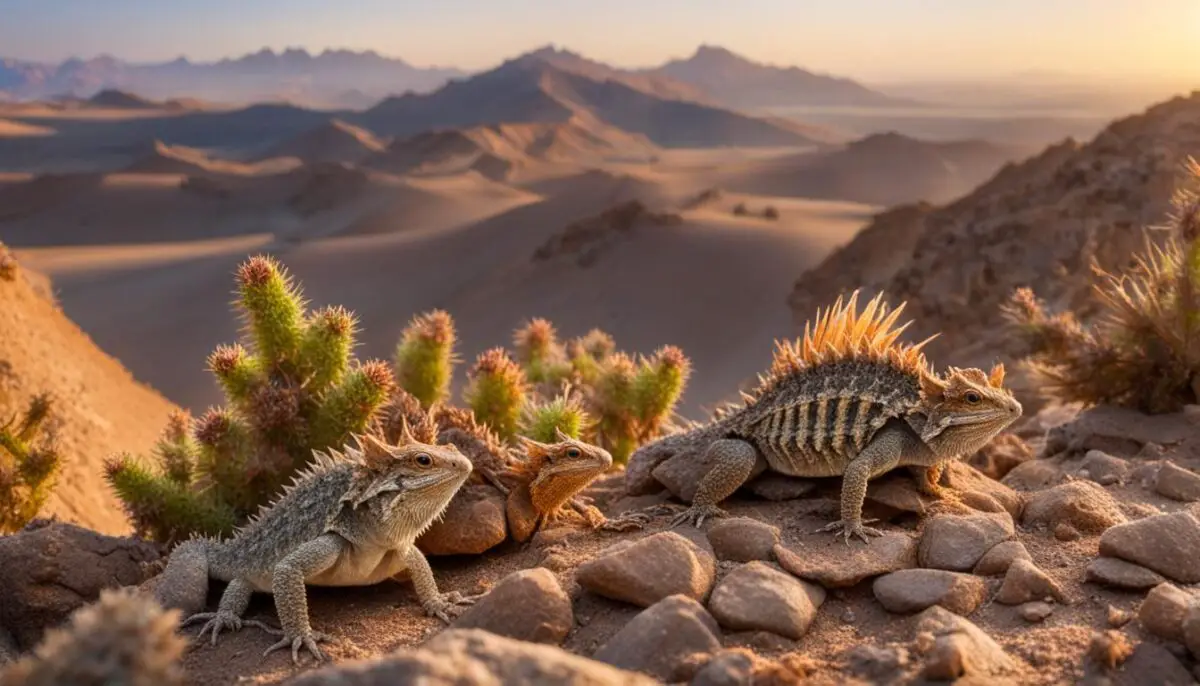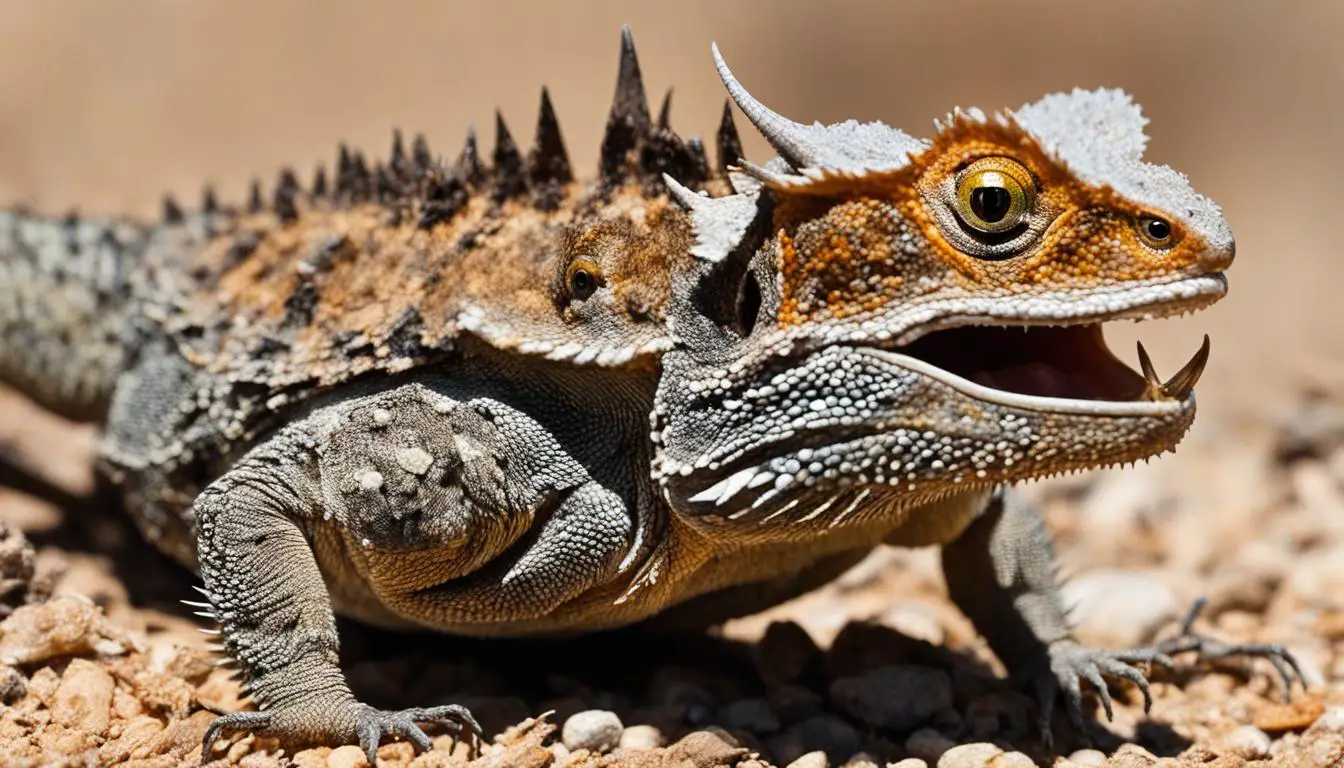Horned lizards, also known as horny toads, have captured the fascination of reptile enthusiasts and nature lovers alike. Found across North America, from Canada to Mexico, these unique creatures have a varied diet that reflects their adaptability to different environments.
The natural diet of horned lizards primarily consists of ants, making them an essential component of their food habits. However, these lizards also consume other small insects as prey items. With their unique eating habits and specialized feeding behavior, horned lizards have evolved to be efficient predators in their respective habitats.
Key Takeaways:
- Horned lizards primarily feed on ants, but they also consume other small insects as prey.
- Their diet reflects their adaptability to different environments, ranging from oak-pine woodlands to thorn scrub deserts.
- Horned lizards rely on patience rather than stalking their prey and strike when the prey gets too close.
- They have unique defense mechanisms such as flattening themselves out, inflating their bodies, and squirting blood from their eyes when threatened.
- Conservation efforts are crucial to protecting horned lizard habitats and ensuring their survival in the wild.
The Diet of Short-horned Lizards
Short-horned lizards, the most widely distributed of the horned lizards, primarily feed on ants. They are also known to consume other small insects. Unlike some lizards that actively chase their prey, short-horned lizards employ a sit-and-wait strategy, relying on patience to strike out when their prey, such as ants and other small insects, approaches too closely.
This feeding behavior allows short-horned lizards to conserve energy while maximizing their chances of capturing their main food source. By strategically positioning themselves and waiting for the opportune moment, they are able to secure their prey without expending unnecessary energy.
Short-horned lizards are well-adapted to their diet of ants and small insects. They possess specialized adaptations in their mouths and digestive systems that allow them to efficiently capture and digest their prey. Their flattened bodies and camouflaged coloration further aid in their ambush hunting strategy, allowing them to blend seamlessly into their surroundings while lying in wait.

This image showcases the agility and distinct characteristics of short-horned lizards, as they patiently wait for their next meal.
The Ant Specialist: Desert Horned Lizards
Desert horned lizards are known as ant specialists, with a particular affinity for large-bodied harvester ants. These lizards have a specialized sticky tongue that allows them to capture their preferred prey. Alongside ants, desert horned lizards also consume other insects, such as spiders, and even vegetation when necessary. This versatility in their diet enables them to survive in different conditions and ensures a consistent food source.
During drought years when ants might be scarce, desert horned lizards exhibit remarkable adaptations. They limit their growth, reproduction, and above-ground activities to conserve energy. Additionally, they have the ability to bury themselves in the soil, keeping cool and camouflaged in their arid desert habitat.
Desert horned lizards play a vital role in regulating ant populations, especially the harvester ants they specialize in. By consuming these ants, they help maintain balance within the ecosystem and prevent outbreaks of these particular species. This natural pest control service underscores the importance of conserving their habitats and protecting their populations.
The Diet of Desert Horned Lizards:
Below is a breakdown of the diet of desert horned lizards:
| Preferred Prey | Other Food Sources |
|---|---|
| Large-bodied harvester ants | Insects |
| Spiders | |
| Vegetation |

Note: Image illustrates a desert horned lizard in its natural habitat.
Horned Lizard Feeding Behavior and Predators
Horned lizards, including short-horned and desert species, exhibit unique foraging behavior in their search for prey. They can be found in open areas, patiently waiting or actively scanning for unsuspecting ants or other small food items. When the opportunity arises, horned lizards swiftly capture their prey with a quick flick of their tongue and consume it whole.
However, while foraging, horned lizards face the constant threat of predation from various animals in their environment. Predators such as hawks, roadrunners, snakes, coyotes, and even domestic pets pose a significant risk to these lizards while they are foraging for food.
In response to the presence of predators, horned lizards have developed unique defense mechanisms to increase their chances of survival. When threatened, they have the remarkable ability to squirt blood from their eyes, which not only startles predators but also contains chemicals that are believed to deter or distract them. Additionally, horned lizards have the ability to inflate their bodies, making themselves appear larger and more intimidating to potential predators.
Horned Lizard Feeding Behavior
- Horned lizards forage in open areas, patiently waiting or actively searching for prey
- They capture prey with a quick flick of the tongue and consume it whole
Horned Lizard Predators
- Various predators pose a threat to horned lizards, including hawks, roadrunners, snakes, coyotes, and domestic pets
“Horned lizards have evolved fascinating defense mechanisms, such as squirting blood from their eyes and inflating their bodies, to deter predators and increase their chances of survival.”
Understanding the feeding behavior and predators of horned lizards is essential in appreciating their unique adaptations and the challenges they face in their natural habitats.

Habitat and Regional Variations
Horned lizards have evolved to inhabit a wide range of arid and semi-arid environments, displaying remarkable adaptability to various habitats. From oak-pine woodlands to thorn scrub deserts, these unique reptiles have found a niche in diverse ecosystems.
Each species of horned lizard exhibits specific habitat preferences and shows regional variations in their diet and behavior. Let’s explore some examples of the different habitats where horned lizards can be found:
Oak-Pine Woodlands
In oak-pine woodlands, horned lizards take advantage of the vegetation and prey items that are abundant in this habitat. The mix of oak trees and pine forests provides a suitable environment for these reptiles, allowing them to thrive.
Thorn Scrub Deserts
In thorn scrub deserts, horned lizards have adapted to the harsh conditions by developing specialized behaviors and physical traits. They rely on camouflage to blend into their surroundings and withstand the extreme temperatures of these arid environments.
As horned lizards traverse these regional variations in habitat, they face unique challenges and opportunities that shape their diet and lifestyle.
Regional variations in food availability and environmental conditions have resulted in distinctive adaptations among different populations of horned lizards. For instance, certain species may have preferences for specific types of ants or small insects found in their respective regions.
To illustrate these regional variations, consider the following table showcasing the habitat preferences and diet variations of different horned lizard species:
| Horned Lizard Species | Habitat | Primary Diet |
|---|---|---|
| Texas Horned Lizard | Grasslands | Harvester ants, grasshoppers |
| Short-horned Lizard | Prairies, sagebrush steppe | Ants, beetles, grasshoppers |
| Desert Horned Lizard | Sandy deserts, rocky slopes | Harvester ants, other insects |
As you can see, each species has adapted to its specific habitat, utilizing the food resources available to them in their respective regions.
Understanding these regional variations is vital for conservation efforts, as it helps identify the specific needs and vulnerabilities of different horned lizard populations. By protecting their unique habitats and preserving their natural food sources, we can ensure the survival of these fascinating reptiles for generations to come.

Human Interaction and Horned Lizards
Horned lizards have a fascinating history of interaction with humans, including being kept as pets. However, it’s important to note that keeping horned lizards in captivity is not recommended. These unique creatures require specialized care and have specific needs that can be challenging to meet in a captive environment. As a result, many captured lizards eventually die due to the difficulty of providing proper care.
Furthermore, it is illegal to possess or trade many species of horned lizards without the appropriate permits. This legislation is in place to protect wild populations from exploitation and ensure their long-term survival. It’s crucial to respect these regulations and avoid contributing to the illegal possession and trade of horned lizards.
Education about the proper care and conservation of horned lizards is vital. By increasing awareness and understanding of their unique requirements, we can help ensure the well-being and preservation of these captivating reptiles in their natural habitats.
Comparison of Horned Lizards as Pets
| Aspect | Horned Lizards as Pets |
|---|---|
| Difficulty in Captivity | High |
| Specialized Care | Required |
| Legal Considerations | Illegal without proper permits |
| Availability of Resources | Limited |
| Conservation Impact | Supports illegal trading and removal from the wild |
Conclusion
Understanding the unique feeding habits and diet of horned lizards is crucial for their conservation and the preservation of their habitats. These fascinating reptiles primarily rely on a diet of ants, supplemented by other small insects and vegetation. However, they face numerous threats, including habitat loss and a reduction in their prey.
In order to protect and ensure the survival of horned lizards for future generations, conservation efforts must be prioritized. This includes preserving and restoring their natural habitats, as well as raising awareness about the importance of these remarkable creatures and the role they play in their ecosystems.
By safeguarding the environments where horned lizards thrive, we can help maintain the delicate balance of nature and prevent further decline in their populations. Together, we can make a difference in the preservation of these unique reptiles and their essential role in our ecosystem.
FAQ
What do horned lizards eat?
Horned lizards primarily feed on ants, but they also consume other small insects.
Do horned lizards eat anything other than ants?
Yes, horned lizards may also eat other small insects, spiders, and vegetation.
How do horned lizards catch their prey?
Horned lizards use a quick flick of their tongue to capture their prey and swallow it whole.
What are the main predators of horned lizards?
The main predators of horned lizards include coyotes, hawks, snakes, and humans.
What defense mechanisms do horned lizards have?
Horned lizards have unique defense mechanisms such as flattening themselves out, inflating their bodies, and squirting blood from their eyes.
Where do horned lizards live?
Horned lizards inhabit a variety of arid and semi-arid environments, ranging from oak-pine woodlands to thorn scrub deserts.
What are the threats to horned lizards and what conservation efforts are being made?
The threats to horned lizards include habitat loss due to agriculture and urban conversion, reduction of prey, and over-harvesting for the pet and curio trades. Conservation efforts aim to protect and restore horned lizard habitats and educate the public about their importance.
Can horned lizards be kept as pets?
Keeping horned lizards in captivity is not recommended as they are difficult to care for and many captured lizards eventually die due to improper care. In addition, it is illegal to possess or trade many species of horned lizards without the appropriate permits.
Why is understanding the diet and feeding habits of horned lizards important?
Understanding the diet and feeding habits of horned lizards is crucial to their conservation and preservation. It helps us protect their habitats and ensure their survival in the wild.


